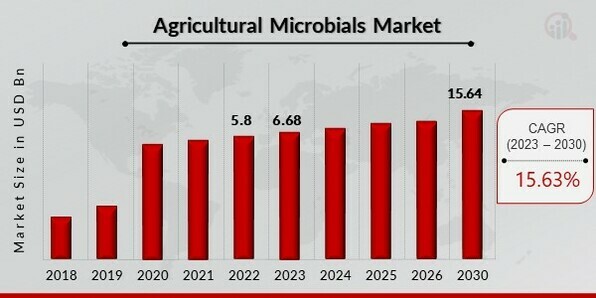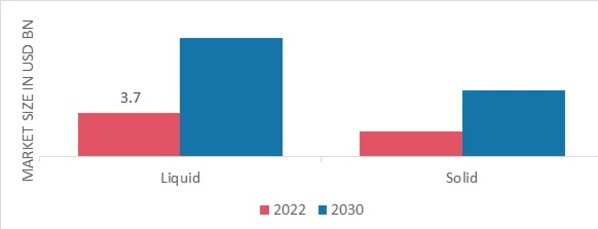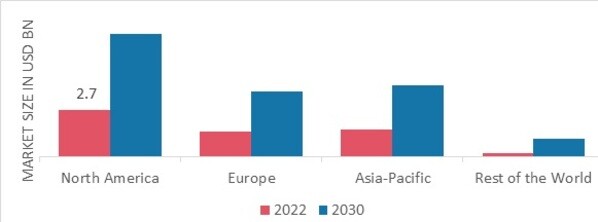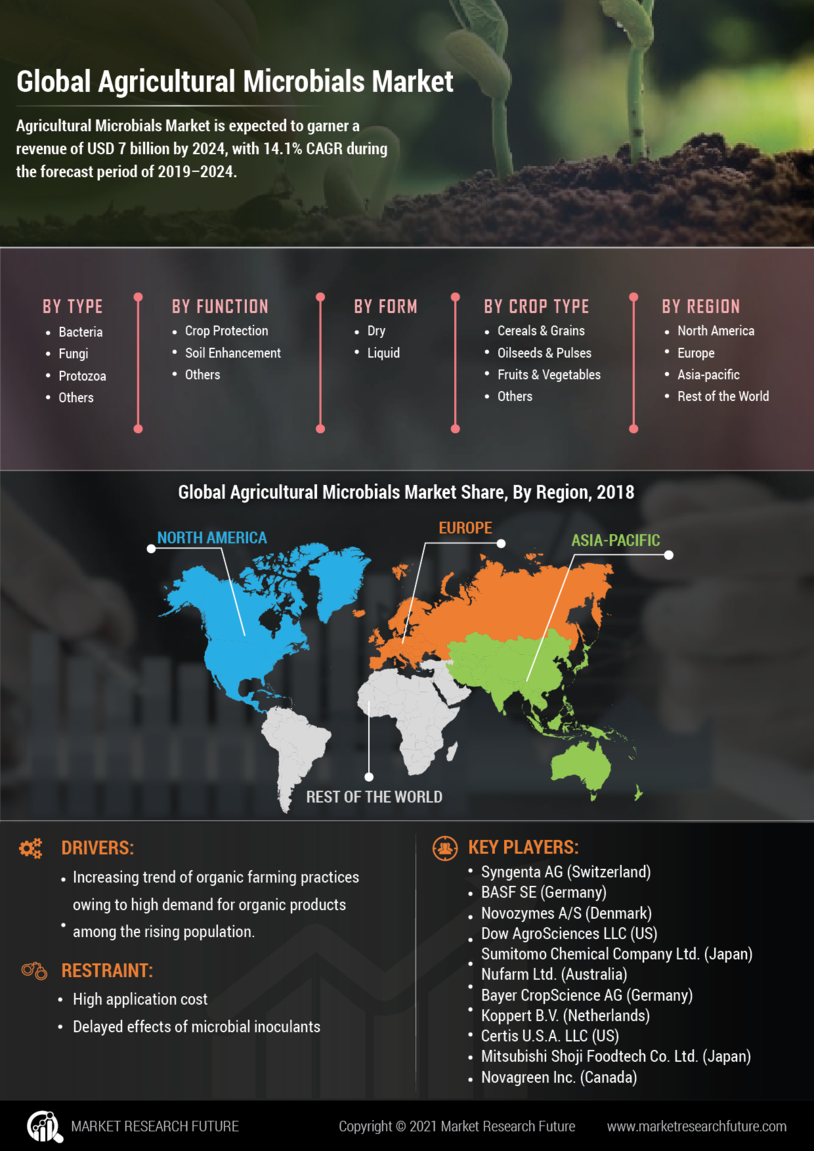Global Agricultural Microbials Market Overview
Agricultural Microbials Market Size was valued at USD 5.8 billion in 2022. The Agricultural Microbials market industry is projected to grow from USD 6.68 Billion in 2023 to USD 15.64 billion by 2030, exhibiting a compound annual growth rate (CAGR) of 15.63% during the forecast period (2023 - 2030). The rising frequency of cervical spondylosis among corporate workers and the increasing occurrences of cervical injuries in vehicle accidents are the key market drivers enhancing the Agricultural Microbials market growth. Source: Secondary Research, Primary Research, MRFR Database and Analyst Review
Source: Secondary Research, Primary Research, MRFR Database and Analyst Review
Agricultural Microbials Market Trends
The industry grew due to the expanding trend of organic farming, which aims to reduce negative environmental effects and promote sustainability. The need for agricultural microbials is projected to be supported by the rising potential of organic farming techniques. In the upcoming years, this factor is projected to drive up demand for crop protection products and natural plant growth regulators.
Synthetic pesticides and fertilizers have been found to have harmful impacts on the environment and human health. Many initiatives are made to enhance farm management techniques due to the significant ecological harm caused by synthetic fertilizers. According to the United Nations and the Food and Agriculture Organization, synthetic fertilizers are responsible for 13% of all agricultural greenhouse gas (GHG) emissions. Prominent companies and other governmental and non-governmental organizations promote sustainable agricultural methods by offering financial aid and subsidies for agricultural microbes, which are essential to such methods. Thus, this factor is driving the Agricultural Microbials market CAGR.
The use of microbes has certain advantages, including improved crop output, nutrient absorption, and organic farming. The need for sustainable farming is rising, and the world's expanding population is fueling this desire. The general people are becoming increasingly aware of the negative consequences of manmade chemicals on health. Moreover, the growing need for microbial for sustainable agricultural intensification is anticipated to support Agricultural microbial market expansion. Because of this, they are more in demand and popular as a biological source to increase output, and their inclusion in integrated farming techniques is expected to reduce yield gaps. Moreover, the expansion of the agricultural microbials market is anticipated to be fueled by microbials' affordability and eco-friendliness.
By 2050, the FAO predicts that there will be 9 billion people on the planet, increasing the need for food to sustain the expanding population. Also, the use of microbial products is being driven by public worries about the safety of their food and the environment. The need for crop intensification (the ability to increase yields per acre while pursuing increasingly sustainable practices), the search for biological substitutes to increase production while putting less stress on the environment, or the addition of integrated practices to close the yield gap is some additional factors driving the demand for microbial. Thus, this aspect is anticipated to accelerate Agricultural Microbials market revenue.
Agricultural Microbials Market Segment Insights
Agricultural Microbials Type Insights
Based on type, the Agricultural Microbials market segmentation includes Bacteria, Fungi, Protozoa, and Others. The Bacteria Agricultural Microbials segment held the majority share in 2022, contributing around 65-67% concerning the Agricultural Microbials market revenue. The primary reason anticipated to increase its demand in the next years is the widespread use of bacteria in formulating biopesticides, biofertilizers, and biostimulants. Bacteria help plants develop in various ways, and some have even been linked to protective microorganisms that control root-fungus illness. Also, many other types of bacteria are easily accessible in the environment, making up most of the microorganisms in the soil (around 95%).
Agricultural Microbials function Insights
Based on function, the Agricultural Microbials market segmentation includes Crop Protection, Soil Enhancement, and Others. The Soil Enhancement segment dominated the market in 2022 and is projected to be the faster-growing segment during the forecast period, 2022-2030. Over the projected period, the soil amendment segment is anticipated to rise due to the widespread use of agricultural microbes for crop protection. Many plant diseases and pests have been successfully controlled using microbial-based remedies. Farmers are now using these bacteria as cost-efficient and long-lasting crop protection methods. Additionally, the demand for microorganisms will rise due to their greater implementation of Integrated Pest Management (IPM) techniques.
Agricultural Microbials Form Insights
The Agricultural Microbials market data has been bifurcated by form into Dry and Liquid. The Liquid segment dominated the market in 2022 and is projected to be the faster-growing segment during the forecast period, 2022-2030. Due to its simplicity of use, the product's liquid formulation is predicted to have the biggest market share. It may be applied directly as sprays, drenches, and root dips and is more practical than the dry formulation. Also, it does not call for prior steps, such as mixing, which helps prevent rotting.
Figure 1: Agricultural Microbials Market, by Form, 2022 & 2030 (USD billion) Source: Secondary Research, Primary Research, MRFR Database and Analyst Review
Source: Secondary Research, Primary Research, MRFR Database and Analyst Review
Agricultural Microbials Crop Type Insights
The Agricultural Microbials industry has been segmented based on crop type into Cereals & Grains, Oilseeds & Pulses, Fruits & Vegetables, and Others. Fruits & Vegetables held the largest segment share in 2022. Because of the high monetary value attached to such commodities, there is an increasing demand for high-value crops, including fruits and vegetables. Agricultural microbes aid in supplying these crops with crucial nutrients. The rising demand for organic fruits and vegetables is anticipated to encourage microbial use for their cultivation. Microbials are also significantly more cost-effective when used to cultivate fruits and vegetables. Over the projection period, this factor is anticipated to increase its demand.
Agricultural Microbials Regional Insights
By region, the study provides market insights into North America, Europe, Asia-Pacific and the Rest of the World. The North American Agricultural Microbials market, accounted for USD 2.65 billion in 2022 and is expected to exhibit a significant CAGR growth during the study period. This is because farmers are becoming more aware of the advantages such microbes have for the environment and because organic agricultural methods are becoming more popular. The area encourages using microorganisms by providing supportive legislative and regulatory frameworks. Organizations like the National Science Foundation (NSF) and the U.S. Department of Agriculture (USDA) stimulate research and development initiatives to achieve microbial diversity and ensure the long-term supply of plant-associated microorganisms. Also, the major businesses in the area are maximizing the development of new products and strategic alliances to provide microbiological solutions for effective and sustainable farming.
Further, the major countries studied in the market report are The U.S., Canada, Germany, France, the U.K., Italy, Spain, China, Japan, India, Australia, South Korea, and Brazil.
Figure 2: AGRICULTURAL MICROBIALS MARKET SHARE BY REGION 2022 (%) Source: Secondary Research, Primary Research, MRFR Database and Analyst Review
Source: Secondary Research, Primary Research, MRFR Database and Analyst Review
Over the projection period, Europe Agricultural Microbials market is anticipated to have the second-largest market share. Microbials are now the focus due to strict restrictions and the negative impacts of synthetic chemicals, which are predicted to boost the market. The use of biopesticides and biofertilizers has increased as organic farming has spread quickly in Germany, Italy, Denmark, and Spain. Further, the Germany Agricultural Microbials market held the largest market share, and the U.K. Agricultural Microbials market was the fastest-growing market in the European Region.
The overall expansion of the Asia Pacific Agricultural Microbials market is supported by the Region's growing knowledge of the advantages of microbial-based crop protection products and their capacity to enhance soil fertility. India and China rely heavily on agriculture, accounting for a large portion of their GDPs. These nations have also begun placing a higher priority on environmental preservation and restoration, which prompted the use of agricultural microbes. As a result, it is anticipated to create new chances for agri-microbes to thrive in the area. Moreover, the China Agricultural Microbials market held the largest market share, and the India Agricultural Microbials market was the fastest-growing market in the Asia-Pacific region.
Agricultural Microbials Key Market Players & Competitive Insights
Leading market players are investing a lot of money in R&D to expand their product portfolios, which will spur further market growth for Agricultural Microbials. With significant industry changes, including new product releases, contractual agreements, mergers and acquisitions, increased investments, and collaboration with other organizations, market developments are also undertaking various strategic activities to expand their presence. To grow and remain in a market that is becoming increasingly competitive, Agricultural microbial industry competitors must provide affordable products.
Manufacturing locally to cut operational costs is one of the main business tactics the Agricultural microbial industry uses to serve customers and increase the market sector. The Agricultural microbial industry has recently given medicine some of the most important advantages. The Agricultural Microbials market major player such as Syngenta AG (Switzerland), BASF SE (Germany), Novozymes A/S (Denmark), Dow AgroSciences LLC (U.S.), Sumitomo Chemical Company Ltd. (Japan), Nufarm Ltd. (Australia), Bayer CropScience AG (Germany), Koppert B.V. (Netherlands), Certis U.S.A. LLC (U.S.) and others are working on expanding the market demand by investing in research and development activities.
With its management headquarters in Basel, Switzerland, Syngenta AG provides agricultural research and technology, focusing particularly on seeds and insecticides. ChemChina, a state-owned company in China, owns it. Valagro, a renowned biological firm, will be acquired by Syngenta Group in October 2020, the company stated. Valagro will continue to run as a separate brand within the Syngenta Crop Protection division. Syngenta Crop Protection's present selection of biostimulants and biocontrols and its upcoming pipeline of biological solutions would be complemented by Valagro's well-established portfolio of specialized nutrients and biostimulants.
One of the biggest pharmaceutical firms in the world is Bayer AG, a German pharmaceutical and biotechnology corporation. In addition to medicines, Bayer sells consumer healthcare items, agricultural chemicals, seeds, and biotechnology goods. Bayer is based in Leverkusen. Ginkgo Bioworks and Bayer CropScience struck a contract in April 2022 under which Ginkgo Bioworks would purchase Bayer's internal discovery and lead optimization platform and the West Sacramento Biologics Research & Development location. This arrangement will likely hasten the growth of Bayer's diverse line of top-notch microbial-based products for growers worldwide.
Key Companies in the Agricultural microbial market include
- Syngenta AG (Switzerland)
- BASF SE (Germany)
- Novozymes A/S (Denmark)
- Dow AgroSciences LLC (U.S.)
- Sumitomo Chemical Company Ltd. (Japan)
- Nufarm Ltd. (Australia)
- Bayer CropScience AG (Germany)
- Koppert B.V. (Netherlands)
- Certis U.S.A. LLC (U.S.)
Agricultural Microbials Industry Developments
- September 2021: Valent BioSciences LLC and Kansas State University, Manhattan, established a formal long-term partnership to develop important research in soil health and carbon-aware farming. The combined study team would examine the interactions between soil conservation management techniques and MycoApply brand soil inoculants, which include arbuscular mycorrhizal fungus, to impact soil health.
- October 2021: UPL and Chr. Hansen, a bioscience business, established a long-term strategic partnership to create microbial-based BioSolutions (biostimulants and biopesticides) that would aid producers worldwide in battling pests and illnesses and enhancing crop quality and yields.
- December 2020: In order to market Marrone Bio Innovations, Inc.'s Pro Farm Technology product line, PGG Wrightson Seeds and Marrone struck a distribution partnership. A novel solution that would assist farmers in growing more crops and producing healthier plants was introduced to the Uruguayan market when UBP Seed Treatment.
Agricultural Microbials Market Segmentation
Agricultural Microbials Type Outlook
- Bacteria
- Fungi
- Protozoa
- Others
Agricultural Microbials Function Outlook
- Crop Protection
- Soil Enhancement
- Others
Agricultural Microbials Form Outlook
Agricultural Microbials Crop Type Outlook
- Cereals & Grains
- Oilseeds & Pulses
- Fruits & Vegetables
- Others
Agricultural Microbials Regional Outlook
- North America
- US
- Canada
- Europe
- Germany
- France
- UK
- Italy
- Spain
- Rest of Europe
- Asia-Pacific
- China
- Japan
- India
- Australia
- South Korea
- Australia
- Rest of Asia-Pacific
- Rest of the World
- Middle East
- Africa
- Latin America
| Report Attribute/Metric |
Details |
| Market Size 2022 |
USD 5.8 billion |
| Market Size 2023 |
USD 6.68 billion |
| Market Size 2030 |
USD 15.64 billion |
| Compound Annual Growth Rate (CAGR) |
15.23% (2023-2030) |
| Base Year |
2022 |
| Market Forecast Period |
2023-2030 |
| Historical Data |
2019 - 2021 |
| Market Forecast Units |
Value (USD Billion) |
| Report Coverage |
Revenue Forecast, Market Competitive Landscape, Growth Factors, and Trends |
| Segments Covered |
Product Type, Operating Platforms, and Region |
| Geographies Covered |
North America, Europe, Asia Pacific, and the Rest of the World |
| Countries Covered |
The U.S, Canada, Germany, France, the U.K., Italy, Spain, China, Japan, India, Australia, South Korea, and Brazil |
| Key Companies Profiled |
Syngenta AG (Switzerland), BASF SE (Germany), Novozymes A/S (Denmark), Dow AgroSciences LLC (U.S.), Sumitomo Chemical Company Ltd. (Japan), Nufarm Ltd. (Australia), Bayer CropScience AG (Germany), Koppert B.V. (Netherlands), Certis U.S.A. LLC (U.S.) |
| Key Market Opportunities |
· Microorganisms are gaining importance as a major component |
| Key Market Dynamics |
· Growing customer demand for organic food · Growing Knowledge About the Use of Synthetic Chemicals to Support Market Development |
Agricultural Microbials Market Highlights:
Frequently Asked Questions (FAQ) :
The Agricultural Microbials market size was valued at USD 5.8 Billion in 2022.
The Agricultural Microbials market is projected to grow at a CAGR of 15.23% during the forecast period, 2022-2030.
North America had the largest share in the Agricultural Microbials market.
The key players in the Agricultural Microbials market are Syngenta AG (Switzerland), BASF SE (Germany), Novozymes A/S (Denmark), Dow AgroSciences LLC (U.S.), Sumitomo Chemical Company Ltd. (Japan), Nufarm Ltd. (Australia), Bayer CropScience AG (Germany), Koppert B.V. (Netherlands), Certis U.S.A. LLC (U.S.).
The Bacteria Agricultural Microbials category dominated the market in 2022.
The Liquid form had the largest share in the Agricultural Microbials market.






 Source: Secondary Research, Primary Research, MRFR Database and Analyst Review
Source: Secondary Research, Primary Research, MRFR Database and Analyst Review Source: Secondary Research, Primary Research, MRFR Database and Analyst Review
Source: Secondary Research, Primary Research, MRFR Database and Analyst Review Source: Secondary Research, Primary Research, MRFR Database and Analyst Review
Source: Secondary Research, Primary Research, MRFR Database and Analyst Review



















